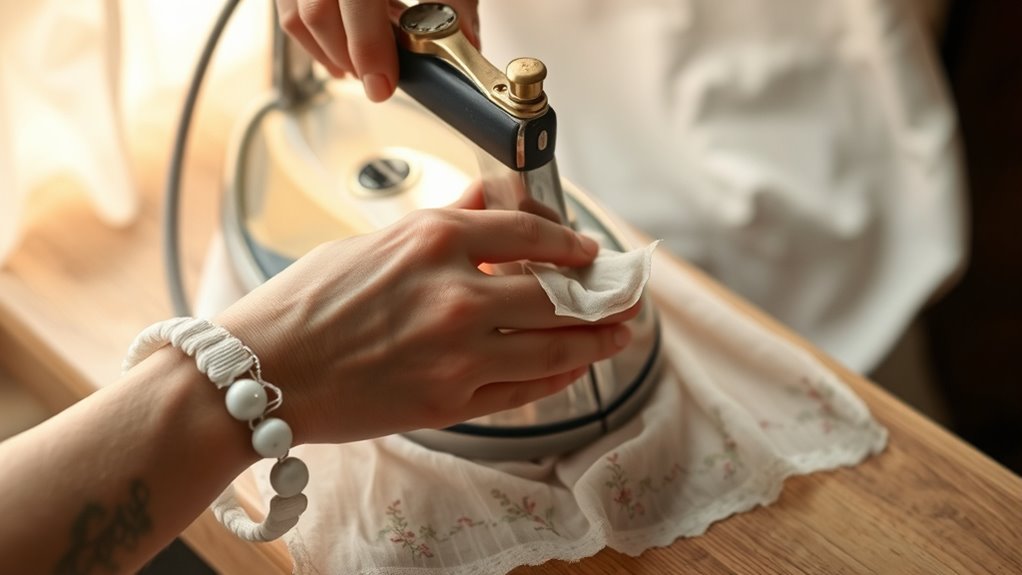To care for delicate fabrics at home, avoid using high heat or aggressive pressing. Instead, hand wash with lukewarm water and mild detergent, gently soaking and avoiding wringing. Lay fabrics flat to dry in a well-ventilated area, away from direct sunlight and heat. Use steaming or low-heat ironing with a pressing cloth if needed. Following these gentle methods helps preserve your delicate items, and there’s more to discover if you keep exploring proper fabric care tips.
Key Takeaways
- Use low heat and a pressing cloth when ironing delicate fabrics to prevent damage.
- Prefer steaming over ironing to remove wrinkles safely without direct contact.
- Always ensure fabrics are completely dry before ironing or steaming to avoid water spots.
- Avoid using the tumble dryer; instead, lay garments flat to dry, preserving fabric integrity.
- Handle embellishments delicately and test small areas before applying heat to prevent discoloration.

Delicate fabrics like silk, lace, and chiffon require special care to maintain their beauty and longevity. These fabrics are fragile and can easily be damaged if you’re not cautious. Instead of tossing them into the washing machine, you should consider hand washing your delicate items. Hand washing allows you to gently clean the fabric without subjecting it to harsh agitation or high temperatures. Fill a clean basin or sink with lukewarm water and add a mild detergent specifically designed for delicate fabrics. Submerge your garment, gently agitate it, and let it soak for about 10-15 minutes. Avoid wringing or twisting the fabric, as this can cause stretching or distortion. Proper fabric care techniques ensure the longevity of your delicate garments and help maintain their appearance over time.
After washing, proper drying is vital. Delicate drying means you should never hang your fabric in direct sunlight or use a tumble dryer, which can weaken fibers and cause shrinking or fading. Instead, lay your garment flat on a clean, dry towel. Gently roll the towel to absorb excess water, then reshape the fabric if needed. Laying your delicate fabric flat helps maintain its shape and prevents stretching. Keep it in a well-ventilated area, away from direct sunlight or heat sources, until it’s completely dry. This careful drying process preserves the fabric’s color, texture, and structure, making it look fresh and new for longer.
When it comes to caring for delicate fabrics, avoid aggressive scrubbing or twisting, as this can damage the fibers. If your garment has embellishments like beads or lace trims, handle it even more gently. For stubborn stains, spot clean with a mild detergent or specialized stain remover, but always test a small area first to guarantee it won’t discolor or weaken the fabric. Ironing delicate fabrics requires extra caution. Use a low heat setting or place a pressing cloth between the iron and the fabric to prevent scorching or shiny marks. Alternatively, steaming can be a safer option to smooth out wrinkles without direct contact.
Frequently Asked Questions
Can I Iron Delicate Fabrics With a Regular Iron?
You might think using a regular iron on delicate fabrics is fine, but it’s a common ironing pitfall that can cause fabric damage. Regular irons often have high heat settings that are too harsh, risking burns or shiny marks. To avoid these issues, always check fabric care labels and use a low heat setting or a pressing cloth. This way, you protect your delicate fabrics from unnecessary harm and keep them looking their best.
What Are Alternative Methods to Remove Wrinkles From Delicate Fabrics?
You might worry about damaging delicate fabrics, but there are gentle alternatives to ironing. Try a steam treatment, holding a steamy cloth over the fabric to relax wrinkles without heat. You can also gently stretch the fabric by hand after steaming to smooth out creases. These methods protect your delicate items while effectively removing wrinkles, so you can keep your clothes looking fresh without risking harm.
How Do I Prevent Color Fading When Caring for Delicate Textiles?
To prevent color fading when caring for delicate textiles, you should focus on fabric dyeing and color preservation techniques. Always wash delicate fabrics in cold water and use a gentle detergent designed for color protection. Turn garments inside out before washing, avoid harsh scrubbing, and skip the bleach. Air dry instead of machine drying, and store items away from direct sunlight to maintain vibrant colors and prolong fabric life.
Are There Specific Storage Tips for Maintaining Fabric Integrity?
Your delicate fabrics deserve the best storage tips to boost their longevity more than you’d imagine! Store them in a cool, dry place away from direct sunlight, and use breathable containers or cotton bags to prevent damage. Avoid plastic, which traps moisture. Folding gently and placing tissue paper between folds keeps fabrics smooth and preserves their quality. These simple steps will help maintain your textiles’ beauty and extend their lifespan.
How Often Should Delicate Fabrics Be Washed to Preserve Quality?
You should wash delicate fabrics only when necessary to preserve their quality and extend fabric lifespan. Gentle washing methods, such as hand washing or using a delicate cycle, help prevent damage from frequent laundering. Avoid over-washing, as this can weaken fibers over time. By caring for your delicate items with gentle washing and minimal frequency, you guarantee they stay beautiful and intact for longer, maintaining their original look and feel.
Conclusion
Caring for delicate fabrics might seem intimidating, but with the right techniques, you can keep them looking new. Did you know that over 60% of people admit to damaging their delicate clothes by improper washing or ironing? By following gentle methods and avoiding the iron’s ironclad rule, you’ll extend your fabrics’ lifespan and maintain their beauty. So, take the time to care thoughtfully—your wardrobe will thank you for it!









